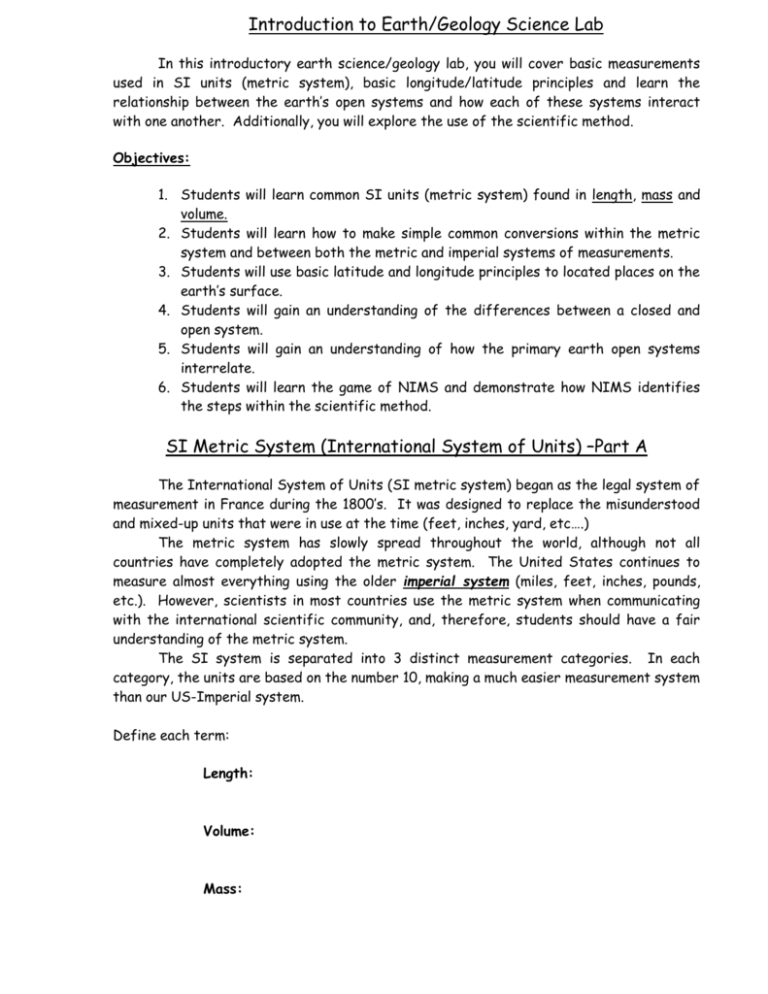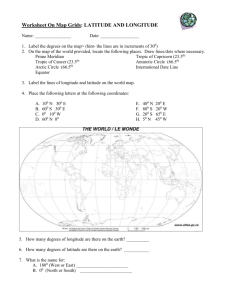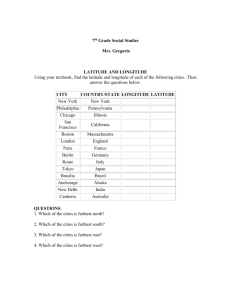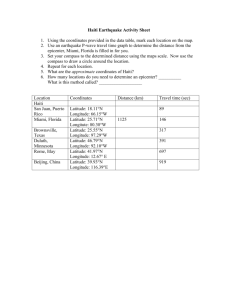Introduction to Earth Science Lab
advertisement

Introduction to Earth/Geology Science Lab In this introductory earth science/geology lab, you will cover basic measurements used in SI units (metric system), basic longitude/latitude principles and learn the relationship between the earth’s open systems and how each of these systems interact with one another. Additionally, you will explore the use of the scientific method. Objectives: 1. Students will learn common SI units (metric system) found in length, mass and volume. 2. Students will learn how to make simple common conversions within the metric system and between both the metric and imperial systems of measurements. 3. Students will use basic latitude and longitude principles to located places on the earth’s surface. 4. Students will gain an understanding of the differences between a closed and open system. 5. Students will gain an understanding of how the primary earth open systems interrelate. 6. Students will learn the game of NIMS and demonstrate how NIMS identifies the steps within the scientific method. SI Metric System (International System of Units) –Part A The International System of Units (SI metric system) began as the legal system of measurement in France during the 1800’s. It was designed to replace the misunderstood and mixed-up units that were in use at the time (feet, inches, yard, etc….) The metric system has slowly spread throughout the world, although not all countries have completely adopted the metric system. The United States continues to measure almost everything using the older imperial system (miles, feet, inches, pounds, etc.). However, scientists in most countries use the metric system when communicating with the international scientific community, and, therefore, students should have a fair understanding of the metric system. The SI system is separated into 3 distinct measurement categories. In each category, the units are based on the number 10, making a much easier measurement system than our US-Imperial system. Define each term: Length: Volume: Mass: LENGTH Before you can truly understand the actual meaning of SI units, you must be able to make “mental conversions” from your learned imperial measurements. Below are some helpful hints to gain an understanding or visual meaning of metric units of lengths. A meter stick equals about 3 feet or a yard (actually 3.28 feet). 1 km equals about half of a mile (actually .62 miles). Although there is no precise standard for the height of a doorknob, it is typically about 1 m. The thickness of a paper clip typically measures 1 mm. The diameter of a DVD or CD is 12 cm or 120 mm. The basic unit for length is the meter. The meter is equal to 3.28 feet (just over a yard) or about 39 inches. Before a student can understand the SI system, it is extremely important to learn the order of metric units. In other words, which units are the smallest or largest? FOR EACH METRIC CATEGORY (Length, Volume, and Mass), KNOW THE ORDER OF INCREASING/DECREASING UNITS. Units of length millimeter (mm) centimeter (cm) decimeter (dm) meter (m) kilometer (km) smallest value largest value VOLUME Volume describes the amount of “space” within a three-dimensional object. For example, “what’s inside the box?” The basic SI unit for volume is the liter. The most common units of volume are known as the milliliter and liter. How do we get a milliliter????? Below is the definition of a milliliter. Consider a cube that measures cm X cm X cm. Calculating the cube’s volume by multiplying Length X Width X Height (cm x cm x cm), the result is 1 cm3. Therefore, 1 cm3 is equal to 1 milliliter (1 mL), if you were able to fill the cube with a liquid. Drop of water fills the cube = 1 ml 1cm 1cm 1cm Above, use your metric ruler and make a cm x cm x cm actual cube which = ____ Below are some helpful hints to gain an understanding or visual meaning of metric units of volume. A typical white sugar cube equals 1 milliliter. 1000 milliliters equals 1 liter of soda. 1 cubic centimeter equals 1 milliliter. Approximately 4 liters make 1 gallon. Units of Volume milliliter smallest liter largest MASS Mass is defined by the amount of matter contained within an object. The more matter, the more mass. The basic unit of mass is the gram (g). There are 3 basic units of mass: the milligram (mg), gram (g) and kilogram (kg). Below are some helpful hints to gain an understanding or visual meaning of metric units of mass. The U.S. penny weighs 2.5 grams. The U.S. nickel weighs exactly 5 grams. A typical paper clip weighs 1 gram. 1 liter of water = 1 kg, 1 cubic meter of water = 1000 liters 1000 liters of water = 1000 kg or 1 metric ton Units of mass milligram gram kilogram smallest largest After learning the “hierarchy” (smallest to largest) of metric units of length, volume, and mass, it is important for the student to compute metric conversions and visualize the quantity. CONVERSIONS Because the metric system is based on the number 10, conversions from one unit to another are relatively simple. Here are two rules in order to make conversions from one unit to another. 1. KNOW which unit is larger or smaller!!!!!!!!!!!!!!!!!!!!!!!!! Examples : cm is smaller than m m is smaller than km mm is smaller than cm mg are smaller than g m is larger than cm km is larger than m cm is larger than mm L are larger than mL 2. KNOW your conversions or how many zeros are in the conversion. Examples : If you convert cm to meters, there are 2 zeros 100 cm = 1 m If you convert mg to g, there are 3 zeros 1000 mg = 1 g If you convert L to mL, there are 3 zeros 1000 mL = 1 L Below are common conversion factors (length, volume, and mass) that students should memorize and be able to visualize. Length 10 mm = 1 cm Volume 1 cm3 = 1 mL Mass 1000 mg = 1 g 100 cm = 1 m 1000 m = 1 km 1000 mL = 1 L 1000g = 1 kg To convert a larger unit to a smaller unit, move the decimal to the according to how many zeros are in the conversions. right Example: 2.5 m = 250 cm (larger to smaller) 100 cm = 1m, there are 2 zeros, so decimal place is moved 2 places to the right To convert a smaller unit to a larger unit, move the decimal to the according to how many zeros are in the conversion. left 3200 mg = 3.20 g (smaller to larger) 1000 mg = 1g, there are 3 zeros, so decimal place is moved 3 places to the left It is also necessary to make conversions between both the metric and imperial systems. Below are common metric to imperial system conversions. 2.54cm = 1 inch 1,609m = 1mi 453.6g = 1lb 3.78L = 1 gal 1m = 3.28 ft 1,609m = 5,280 ft 907.2kg = 1 ton 1 km = .62 mi 28.3g = 1 oz 29.5 mL = 1 fluid oz When converting from metric to the English system (or vice versa), it is necessary to utilize conversion ratios. Example: Convert 389 m to feet 389 m ( 3.28ft/1 m) = 1276 ft Multiply 389 m by the ratio (conversion factor) 3.28 ft/1 m. It is very important that the term 1 m is in the denominator so that meters cancel and feet are left. Example: Convert 1276 ft to meters 1276 ft ( 1m/3.28 ft) = 389 m Multiply 1276 ft by the ratio (conversion factor) 1 m/3.28 ft. Here, the unit ft is in the denominator, so ft cancels and meters are left. LATITUDE AND LONGITUDE – Part B Latitude and Longitude is a coordinate system used for locating specific places on the earth’s surface. Plotting latitude and longitude lines on the earth forms a grid system that results in a “graphical net” surrounding the earth. By locating a specific latitude and longitude (where these lines cross) a geographer can easily locate a general place on the earth. Latitude and longitude is equally important to an earth scientist, because many earth and geological features are identified by their latitude and longitude locations. Below is a diagram illustrating a “map-view” of longitude and latitude. Latitude lines, known as parallels, move “up and down” locating features in the north/south directions while longitude lines move across the globe locating features in the east/west directions. Where both latitude and longitude lines cross the result is a specific location on the earth surface. Longitude East/West direction Latitude North/South direction Using latitude and longitude Locating a specific place on the earth’s surface can be as easy as playing the game Battleship. Latitude and longitude uses a system defined by degrees. For example, 0 degree latitude divides the earth in half (northern and southern hemispheres). In fact, 0 degree latitude is considered the equator. Latitude lines (parallels) are located north and south of the equator (0 degree latitude). Therefore, latitudes can continue north of the equator (northern hemisphere) at 10, 20, 30, 40, 50, 60, 70, 80 and 90 degrees at the North Pole. The opposite holds true in the southern hemisphere where south 90 degrees is found at the South Pole. Meridians of longitude are drawn from the North Pole to the South Pole and are at right angles to the Equator. The “Prime Meridian” which passes through Greenwich, England, is used as the zero line from which measurements are made in degrees east and west to 180°. The 48 conterminous states of the United States are between 67° and 125° west longitude. Any specific geographical point can thus be located by reference to its longitude and latitude. Washington, DC for example, is approximately 39° North latitude, 77° West longitude. Chicago is approximately 42° North latitude, 88° West longitude. Below (next page) is a diagram that illustrates the “layout” of latitude and longitude and the designated degrees. Additionally, observe the latitude and longitude locations for Washington DC and Chicago. Chicago 420 North latitude 880 West longitude Washington DC 390 North latitude 770 West longitude Scientific Method The scientific method attempts to explain the natural occurrences (phenomena) of the universe by using a logical, consistent, systematic method of investigation, information (data) collection, data analysis (hypothesis), testing (experiment), and refinement to arrive at a well-tested, well-documented explanation that is well-supported by evidence, called a theory. The process of establishing a new scientific theory is necessarily a grueling one; new theories must survive an adverse gauntlet of skeptics who are experts in their particular area of science; the original theory may then need to be revised to satisfy those objections. The typical ways in which new scientific ideas are debated are through refereed scientific journals, such as Nature and Scientific American. (Depending upon the area of science, there are many other journals specific to their respective fields that act as referees.) Before a new theory can be officially proposed to the scientific community, it must be well-written, documented, and submitted to an appropriate scientific journal for publication. If the editors of these prestigious publications accept a research article for publication, they are signaling that the proposed theory has enough merit to be seriously debated and scrutinized closely by experts in that particular field of science. Skeptics or proponents of alternative or opposing theories may then try to submit their research and data, while the original proponents of the proposed theory may publish new data that answers the skeptics. It may take many years of often acrimonious debate to settle an issue, resulting in the adoption, modification, or rejection of a new theory. For example, the Alvarez Meteorite Impact theory (a 6-mile wide meteorite struck the earth 65 million years ago, ending the Cretaceous Period and causing extinction of the dinosaurs) was first proposed in 1979 and debated for about 10 years before gaining acceptance from the majority of earth scientists. A successful scientific inquiry may culminate in a well-tested, well-documented explanation (theory) that is supported overwhelmingly by valid data and often has the power to predict the outcome of certain scenarios, which may be tested by future experiments. There are rare examples of scientific theories that have successfully survived all known attacks for a very long time and are called scientific laws, such as Newton's Law of Gravity. Below is a generalized sequence of steps taken to establish a scientific theory: 1. Choose and define the natural phenomenon that you want to figure out and explain. In other words --- Ask a question. 2. Collect information (data) about this phenomenon by going where the phenomenon occurs and making observations. Alternatively, try to replicate the phenomenon by means of a test (experiment) under controlled conditions (usually in a laboratory) that eliminate interference from environmental conditions. 3. After collecting a lot of data, look for patterns in the data. Attempt to explain these patterns by making a provisional explanation, called a hypothesis. 4. Test the hypothesis by collecting more data to see if the hypothesis continues to show the assumed pattern. If the data does not support the hypothesis, it must be changed or rejected in favor of a better one. In collecting data, one must NOT ignore data that contradicts the hypothesis in favor of only supportive data. (That is called "cherry-picking" and is commonly used by pseudo-scientists attempting to scam people unfamiliar with the scientific method.) If a refined hypothesis survives all attacks on it and is the best existing explanation for a particular phenomenon, it is then elevated to the status of a theory. 5. A theory is subject to modification and even rejection if there is overwhelming evidence that disproves it and/or supports another better theory. Therefore, a theory is not an eternal or perpetual truth. The Scientific Method in Earth Science The classic scientific method in which a convenient laboratory experiment may be devised and observed often cannot be done in the earth sciences. This is because most of earth and geological phenomena are too big (earthquakes, volcanic eruptions) or too slow (mountain building, climate change) to be observed easily or replicated; the earth itself is the "laboratory." Also, because many of the events analyzed by geologists occurred long ago, they often "work backwards" - that is, they start with the conclusion (a rock or fossil) and try to work out the sequence of past events that occurred over geologic time. Below is a simple “flow chart” that illustrates the steps within the scientific method. If YOU FAIL, TRY, TRY AGAIN Introduction to Earth Science/Geology Lab Exercises The Metric System (Part A) Using the SI units, answer the following questions. 1. Fill in the following blanks: There are ______ meters in 1 km. There are _____ decimeters in 1 meter. There are _______millimeters in 1 centimeter. There are ______ centimeters in 1 meter. There are _______centimeters in 1 decimeter. There are _______millimeters in 1 decimeter. There are _______millimeters in 1 meter. There are _______grams in 1 kilogram. There are ________milliliters in 1 liter. 2. Using a metric ruler, mark and label millimeters and centimeters. Mark the following measurements. 3.3 cm 4.1 cm 3 mm 3. Calculate the following conversions. 54.2 mm = _____ cm 25.3 cm = _____ m 3.2 cm = _____mm 28.65 mm = _______cm 2.36 L = _______mL 6.23 cm3 = ______ mL 1.3 g = _______ mg .001 m = _____ cm 63.2 cm3 = _____ mL 1.2 cm 5.4 cm 5000 m = _______ km 450.32 cm = _____ m 548 m = _______ km 3548 mL = ______ L 544.3 L = ______mL 120.4 mg = ______ g .00034 g = ______ mg 12.4 g = _________mg 28.125 mL = ______ cm3 4. Calculate the following conversions (show your work). 15.2 m = _____ feet 419 kg = _____ lb 25.6 cm _____ inches 6.15 kg = _____ tons 2.6 km _____ miles 35.2 g = _____ lb 22.5 m _____ miles 5.6 cm3 = _____ fluid oz 28.1 m_____ yards 562 g = ______ oz 55 L = ______ gallons Your weight (lb)______= kg 285 mL = ______ fluid oz 125 L = _____ fluid oz Determining latitude and longitude (Part B) Use an atlas or globe (provided by instructor) to determine the approximate latitude and longitude of the following cities: 1. London, England 2. Bakersfield, CA 3. Shanghai, China ________________ 4. Athens, Greece ______ 5. Sydney, Australia 6. Glasgow, Scotland 7. Albany, Australia ________________ 8. ________________ Baghdad, Iraq 9. Tokyo, Japan ________________ 10. Paris, France ________________ What is located at the following coordinates? 1. 0ºS, 90ºW 2. 37ºN, 117ºW 3. 35ºN, 33ºE 4. 44ºN, 63ºW 5. 3ºS, 60ºW 6. 33ºN, 73ºE









